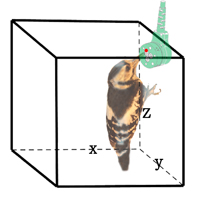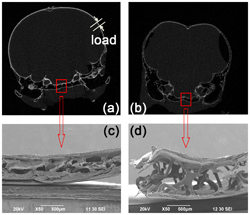
Why Don't Woodpeckers Get Headaches?
What’s in the Story?

If you hit your head against a tree trunk all day long, you probably wouldn’t feel too great and neither would your brain. Woodpeckers do this all the time though. It’s what they’re named for. In the PLOS ONE article, “Why Do Woodpeckers Resist Head Impact Injury: A Biomechanical Investigation,” scientists studied how a woodpecker’s brain survives all that pecking.
Science For the Birds?
Scientists conducted an experiment to see how woodpeckers' brains are protected from damage. First, the scientists chose two types of birds to use in their experiment: the Great Spotted Woodpecker and the Eurasian Hoopoe. The Eurasian Hoopoe is not a woodpecker, but it does peck at soil. Soil is softer than wood, so scientists wanted to compare soil pecking behavior to wood pecking behavior.

The birds were placed in metal cages with high-speed cameras. The cameras let scientists watch birds peck in slow motion. There was also a force sensor in each cage for the birds to peck. The force sensor measured how hard the birds were pecking.
The scientists learned a lot about the path, timing, and speed of woodpecker and hoopoe pecks. They then used that information to see just how it is that woodpeckers can peck all day without giving themselves a massive headache.
How Do Head-banging Birds Avoid Headaches?
The cage experiment helped scientists learn about the behavior and force of pecking. Scientists also wanted to know about the differences between the skulls of the woodpecker and the hoopoe.

The scientists used a special technology called micro-CT to see how the birds’ skulls were shaped. They also used specialized machines to conduct force tests. The force tests measured the strength of the birds’ beaks and skull bones. Scientists did this to see if there was something special about a woodpecker’s head bones that protected its brain from pecking.
After the scientists collected the measurements from the micro-CT scans and force tests, they created realistic models of the bird skulls using computers. You can see an example of one of those models in the gold box at the top of this page.
After all that hard work, the scientists did to the skull models what your little brother used to do with your favorite toys. They smashed them. Using the computer model, they simulated the force of pecking to see what happened. You can think of it as a computer game that tells scientists how the skulls work. By looking at how the models broke or where the skulls were strained in their computer program, scientists could see how force was distributed across the birds’ skulls.
So Why Don’t Woodpeckers Get Headaches?
Have you ever ridden a bike with shocks? If you have, you know that that shocks help make a bumpy ride smoother. Shocks do this by absorbing the impact when you ride over rough terrain. That keeps you comfortable and your bike in one piece. Woodpeckers’ heads are kind of like bike shocks for their brains. The bones in a woodpecker’s skull keep its brain comfortable and avoids concussions.

The scientists confirmed that woodpeckers are pretty good at protecting their noggins, by using a few special tricks:
- Woodpeckers are better than hoopoes at varying the path of their pecks. By moving their beaks around more, woodpeckers minimize brain damage in specific areas.
- Woodpeckers’ skulls are more flexible because of the plate-like bones. That helps to minimize the damage of all that pecking.
- Woodpeckers have a special bone that acts like a seat-belt for its skull. It's called the hyoid bone, and it wraps all the way around a woodpecker's skull. Every time the bird pecks, the hyoid acts like a seat-belt for the bird's skull and the delicate brain it protects.
- Even the woodpeckers’ beaks help. A woodpecker’s upper beak is longer than its lower beak, kind of like an overbite. But when you look inside, you find that the lower beak actually has a longer bone. The lower beak bone ends up taking on the majority of strain. This helps to absorb impact while pecking and puts the strain on the body instead of the brain.
A woodpecker’s skull is like an internal bike helmet to keep its brain from getting hurt. Scientists even think some of the things they found out about woodpeckers can be used to make better helmets. Maybe one day your head will be as well protected from damage as a woodpecker’s brain.
Additional images from Wikipedia Commons and PLOS ONE.
Bibliographic details:
- Article: Why Don't Woodpeckers Get Headaches?
- Author(s): Samantha Hauserman
- Publisher: Arizona State University School of Life Sciences Ask A Biologist
- Site name: ASU - Ask A Biologist
- Date published:
- Date accessed:
- Link: https://askabiologist.asu.edu/plosable/woodpeckers
APA Style
Samantha Hauserman. (). Why Don't Woodpeckers Get Headaches?. ASU - Ask A Biologist. Retrieved from https://askabiologist.asu.edu/plosable/woodpeckers
Chicago Manual of Style
Samantha Hauserman. "Why Don't Woodpeckers Get Headaches?". ASU - Ask A Biologist. . https://askabiologist.asu.edu/plosable/woodpeckers
Samantha Hauserman. "Why Don't Woodpeckers Get Headaches?". ASU - Ask A Biologist. . ASU - Ask A Biologist, Web. https://askabiologist.asu.edu/plosable/woodpeckers
MLA 2017 Style

Be Part of
Ask A Biologist
By volunteering, or simply sending us feedback on the site. Scientists, teachers, writers, illustrators, and translators are all important to the program. If you are interested in helping with the website we have a Volunteers page to get the process started.
